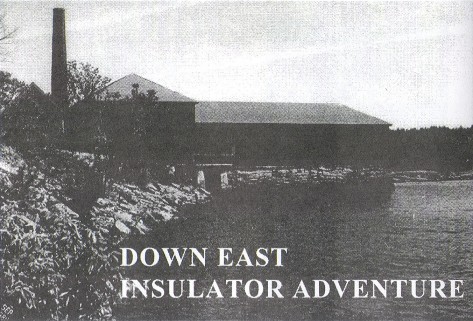Down East Insulator Adventure
by Ed Sewall
Reprinted from "Crown Jewels of the Wire", May 1997, page 18
I started collecting insulators around 1973 and like most collectors at that
time, was only interested in glass items. Although at the time I was ignorant of
the history of porcelain insulators, I had some porcelain insulators in my
collection, mostly chocolate brown or white beehives and signals. Back then I
kept just about any insulator I found and generally did not consider the
porcelain I had seen or owned very interesting.

When I went to college up in
Maine in 1978, I often went on insulator hunts along old railway and power lines
on my own throughout the area. Around 1980, I was exploring an old hydroelectric
plant located in Bangor on the Penobscot River. As I recall, the plant was
abandoned, with the main entrance on the land side boarded up. A long dam
extended all the way across the river from the end of the building. A small
concrete pad containing several disconnected multipart porcelain insulators on
ground mounted pins was on the outside of the building. This pad was fenced in
with a chain link and barb-wire fence preventing access. Sensing that there must
be more insulators in and around the building, I then decided to walk along the
edge of the river to find an access point. When I got to the edge of the old
brick structure and river! used my rock climbing skills and traversed out along
the rough stone foundation, entering the building through one of the large, broken out windows facing the rivers edge.
As soon as I entered the building I flushed a large flock of pigeons from the
rafters where they had taken refuge. The inside of the building was comprised of
two large rooms. The first room had been cleaned out of all equipment and was
pretty much empty except for numerous scattered wine bottles, garbage and pigeon
guano covering the floor. I walked into the second room which also appeared to
be empty. Then I spotted what appeared to be a 3 foot tall pile of debris at the
far end of the building and went to investigate. Much to my surprise it was a
pile of insulators! Much to my disgust, the pile was covered with a thick
coating of pigeon guano! There must have been a couple of hundred insulators in
the pile.
Excitedly, I pulled a few of the insulators off, and, after wiping off
the crusty guano, found that they were all porcelain. Not finding any glass I
was somewhat disappointed. However, I decided I would sort through some of the
pile and take one or two pieces so I didn't go home empty handed. Trying to
avoid the deepest guano, I found two interesting power pieces near the top of
the pile which had an attractive mottled red-brown glaze. After washing them in
the river, I put them in my pack for the walk out.
When I got back to my dorm room I cleaned the insulators off thoroughly and
discovered that they contained marking I previously overlooked. At the time I
had no reference material on porcelain so I ordered Gerald Brown's Collectable
Porcelain Insulators book and eventually Jack Tod's excellent guide book.
Although I am now am very familiar with the large incuse insulator logo with
Victor & R=oo on the pieces, it was new to me at the time. I identified
these insulators as U-926 made by Locke between 1908-1914 time period.
Although
not very rare pieces, like any glazeweld, I still find them desirable,
especially with the unique mottled red-brown glaze colors associated with this
company. These were the insulators that sparked my interest in Locke insulators
and other classic porcelain pieces that continues to this day. I often wonder
what treasures I left behind in that large pile of insulators that I discovered
in that old building in Bangor. I also wonder what those two and three piece
porcelain multi-parts on the outside of the building were. I never returned to
the building after my visit in 1980, and since I now live in Washington state, I
probably never will.
| 